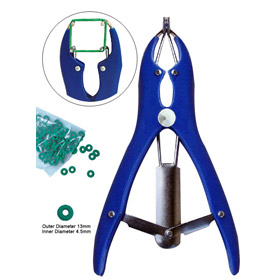Docking
Docking is when the tail is shortened. Docking improves the health and welfare of sheep and lambs. The tail protects the sheep’s anus, vulva, and udder from weather extremes. Sheep lift their tail when they defecate and use their tail, to some extent, to scatter their feces. The ancestor of most modern sheep breeds (Mouflon) is a hair sheep with a short tail. Centuries of selection for wool production has resulted in sheep with long, woolly tails which usually require docking.
Sheep Tail Banding
All lambs are born with tails, much longer than what most adult sheep have. Much like many canines, such as cocker spaniels, sheep have their tails docked by their owners through a process called “banding.” The method is performed with the elastrator
An elastrator is simply a device to get a powerful elastic band around the base of the tail Slide the elastic bands over the four prongs at the top. Squeeze the handle to open. Its simple, easy, bloodless and most commonly used methods. The band cuts off the blood supply to the tail, causing the tail to fall off in 7 to 10 days.
Some people dock lambs as soon as they are born, but its preferred to make sure the lamb is thriving well in the new world before adding another burden to it. Lambs are usually docked at 24 hours of age. It can be done up to ten days old but the longer you wait for the more discomfort the lamb will have. Nerves are not developed yet in the first day of life so they feel nothing during the procedure. This makes sense because they don’t react at all–they are more annoyed at being held.
This method causes the lamb to be very susceptible to tetanus. It is imperative that either a tetanus anti-toxin be administered at the time of docking, or that the mother should be vaccinated with tetanus taxied 2-4 weeks before giving birth. Those immunities will cover the lamb.



